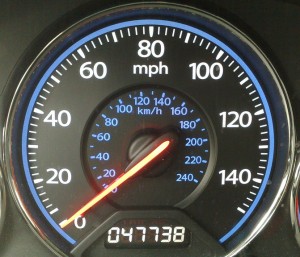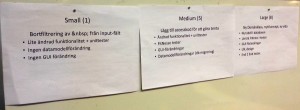One of the most common questions we get is whether to estimate in time or points. It seems like points are used only “to avoid thinking about time” and they are essentially the same. Wrong.
Let us give you the travel metaphor to give you an idea about how we are thinking.
The Travel Metaphor
“Mom, dad, are we there yet?” Recognize that expression? Having problems answering it? Well, you have the same problem giving an answer to your kids as well as to your project manager.
Both will hold you accountable for your answer! And even though you have taken the trip to the grandparents a hundred times, you cannot be sure on how long it will take this time.
You know the distance quite well, but there are a multitude of things that can happen along the way. It may start to rain so you have to lower speed. Someone needs to pee an extra time. You forgot to fill up gas. There’s an accident and you are forced to take a detour.
So you answer “if nothing happens it will take about half an hour, kids.” If something happens, do they care? You said half an hour, didn’t you?
Your travelled distance per hour will be the same every time only if your speed is constant, which it is not. It depends on a number of things like weather, traffic or vehicle.
Compare story estimation with travelling. Your sprint velocity compares to your travelling speed, your story points to the distance and time will be of course the same.
Story points describes the complexity of the problem and that will be fairly constant over time, while time is a function of that complexity and your sprint velocity.
In the same manner, the distance between two cities will remain fairly constant over time but the time it takes to travel between them will vary.
But is not sprint velocity constant? We hope not. We hope that you will increase your velocity over time as you trim down all waste, increase team play and other improvements.
Relative estimation and reference stories
It is hard to estimate in absolute terms, such as out of the blue tell the distance between two cities. But you are surely able to tell if that distance is longer or shorter than the distance between two other cities. E.g. if you know the distances from London to Rome, you can estimate roughly the distance to Paris. This is how we work as humans. We can estimate in relative terms quite well but are not good at absolute estimation.
That is why we have reference stories on the wall when we estimate. A reference story is an example of a story that we can fairly well relate to. A new story can be compared to the reference stories and we can tell whether it is larger or smaller than each one of them.
You should have at least three reference stories. One small, one medium and one that is the largest you would allow in a sprint. Stories bigger than that gets sliced.
You use the reference stories to reason about your estimation with your teammates whenever your estimates diverge.
Also, your estimations will be more consistent over time with reference stories. If you estimate without them, you tend to lower your estimations as you go faster. Like if the distance travelled would shrink as your speed increased.
Remember, we are comparing complexity, which is expected to be stable. Not the time a story takes to reach done. That is different thing which depends on your current sprint velocity.
Why estimate time?
With what has been said, why should anyone consider time estimation at all? Well, it is often time that matters the most. But with relative estimation, if you know the velocity, you can derive the time. For instance, if the velocity varies between 10 and 12, and each sprint is 2 weeks, you know that in 4 weeks the team have delivered between 20 and 24 points.
Returning to the metaphor, people don’t care how far you have to go, they just want to know when you will be there.
Summary
- Estimation in points is estimation of complexity and you can compare it with estimation of travelling distance. Time is depending on sprint velocity and traveling speed, respectively.
- Estimate in points is easier to get accurate. If you estimate consistently, you may be able to measure process improvements in the form of increased velocity.
- To estimate consistently, you should have reference stories at hand to compare with during estimation.
At the end of the day, however, you will need to answer the question on your time of arrival.
http://blog.crisp.se/2014/04/23/perlundholm/time-vs-story-points-estimation

